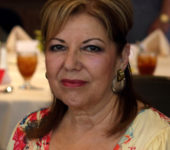• by Rosana G. Rodríguez, Ph.D., and Juanita C. García, Ph.D.• IDRA Newsletter • January 2014 •

In an increasingly interconnected world, fostering early interest in STEM areas is critical to addressing the underrepresentation of girls and minorities in these critical fields. Teachers in dual language classrooms can help ignite and inspire this interest through IDRA’s Semillitas de Aprendizaje early childhood supplemental curriculum. Designed for children in prekindergarten through fifth grade, these tools use storytelling and dramatic presentations that lead to language development, oral language proficiency and scientific thinking.
Educators from across the country recently learned how to use Semillitas de Aprendizaje for this purpose at the annual La Cosecha Dual Language conference in Albuquerque. We used leadership connectivity to the world around us as a backdrop to integrate national science standards into their presentation on using Semillitas de Aprendizaje. This early childhood supplemental curriculum was developed by IDRA through funding by the W. K. Kellogg Foundation in response to the need for high quality, culturally and linguistically responsive educational materials for school and home use.
At the conference, we stressed rigor and relevance for igniting the interest and engaging our youngest learners as emerging young scientists and mathematicians though bilingual storytelling. Hands-on demonstration and interactive presentations connect students with the world around them to further explore scientific and mathematical principles through culturally and linguistically relevant stories, poems, theatre, music and the arts. We also demonstrated how to connect content with experiential learning in the STEM areas, linking literacy and dual language learning.
The Semillitas de Aprendizaje stories can be used effectively in promoting critical thinking and connecting language learning to all content areas, while honoring history, language and culture. The story we demonstrated at this year’s conference, Jesusita y las Arañas ~ Jesusita and the Spiders, can be used to illustrate the scientific method and integrate process skills, science and mathematics, and oral and written language skills by: observing, predicting and evaluating, collecting data, investigating, interpreting data, classifying and forming conclusions, and communicating results (process adapted from Leonard, IBS).
Semillitas de Aprendizaje stories are especially effective in the use of Teatro en el Aula, or Readers’ Theatre, a method that provides opportunities to further engage students in developing oral fluency, a critical factor necessary for reading comprehension. The benefits of this approach with these engaging bilingual children’s stories are multiple, including motivation, meaningful contextualization for re-reading and group performance for thinking, and engaging students in active listening and sharing. Studies show the importance of fluency interaction and comprehension processes (Rasinski, 2003; Fuchs, et al., 2001; Kuhn, 2003). Research on Readers’ Theatre also underscores the benefits of this approach in engaging students and creating meaningful context for re-reading (Tranin & Andrzejeczak, 2006). Working on group performance also fosters engagement and relevance with the text that can enhance comprehension through expression, familiarity and discussion.
Beginning from the strong premise of identifying and valuing what children already know and working from what they have already observed in the natural world, teachers can apply a research process that moves children toward creating a hypothesis and formulating questions about what they want to know more about. IDRA has modified a technique called group memory to inspire scientific observations and inquiry. The process culminates with an evaluative and reflective segment that asks questions to further inspire written language and synthesis. “The strategy and approach is effective at the primary level and can also be used in the intermediate grades,” observed one participant in the session.
By integrating science and mathematics into language learning, teachers can then weave activities grounded in inquiry that develop bilingual skills and oral language in bilingual classrooms by simultaneously introducing mathematics concepts at very young ages, such as graphs, polls, use of graphic organizers and technology for even the youngest learners. This approach should always build upon a perspective that affirms and integrates existing knowledge and vocabulary and that fosters self-efficacy and self-expression.
IDRA’s Semillitas de Aprendizaje offers an array of enchanting stories to engage and ignite interest in math, science, problem solving and critical thinking and that encourage students to pose and investigate questions that are generated by them, flowing naturally and inspired by history, culture and the natural world around them. Dual language learning is promoted by integrating vocabulary and language development across all subject areas.
Teachers also can use the stories to promote sensitive, inquiring and collaborative leaders for the future who are attuned to listening to one another, engaged in joint problem-solving and valuing the diversity of opinions and knowledge of others in the group, while growing in their own knowledge and application of skills. Both oral and aural language development are stressed.
Margaret Wheatley suggests: “Ask, What’s possible? Be intrigued by the differences you hear (and see). Expect to be surprised. Treasure curiosity more than certainty… Remember, you don’t fear people (or creatures) whose story you know. Real listening always brings people closer together.” (2009)
IDRA’s professional development goes beyond techniques to transform the teaching and learning process based upon a valuing perspective that recognizes and honors the knowledge inherent in every student at every level, celebrating the variety of cultural expressions through language.
IDRA will soon release the bilingual Readers’ Theatre for the Semillitas de Aprendizaje storybooks and accompanying lessons process along with storytelling videos in Spanish and English. You can learn more about the series’ Big Books, Storybooks, Math Books, Cartitas–Letters Home and Teacher Guide online at: http://www.semillitasdeaprendizaje.com.
Resources
Fuchs, L., & D. Fuchs, M.K. Hosp. “Oral Reading Fluency as an Indicator of Reading Competence: A Theoretical, Empirical, and Historical Analysis,” Scientific Studies of Reading, 5, 239-256 (2001).
Kuhn, M.R., &S.A. Stahl. “Fluency: A Review of Developmental and Remedial Practices,” Journal of Educational Psychology, 95 (1) 3-21 (2003).
Leonard, N. “What is inquiry-based science (IBS) and how does one teach using IBS?,” Powerpoint presentation (2010).
Rasinski, T.V., & J.V. Hoffman. “Oral Reading in the School Literacy Curriculum,” Reading Research Quarterly, 38 (4), 510-522 (2003).
Tranin, G. & N. Andrzejeczak. Readers’ Theatre: A Viable Reading Strategy? (Lincoln, Nebraska: College of Education and Human Sciences, Great Plains Institute of Reading and Writing, 2006).
Wheatley, M.J. Turning to One Another: Simple Conversations to Restore Hope to the Future (San Francisco Berrett-Koehler Publishers, Inc., 2009).
Rosana G. Rodríguez, Ph.D., is director of development. Juanita C. García, Ph.D., is an education associate in IDRA Field Services. Comments and questions may be directed to them via email at feedback@idra.org.
[©2014, IDRA. This article originally appeared in the January 2014 IDRA Newsletter by the Intercultural Development Research Association. Permission to reproduce this article is granted provided the article is reprinted in its entirety and proper credit is given to IDRA and the author.]


